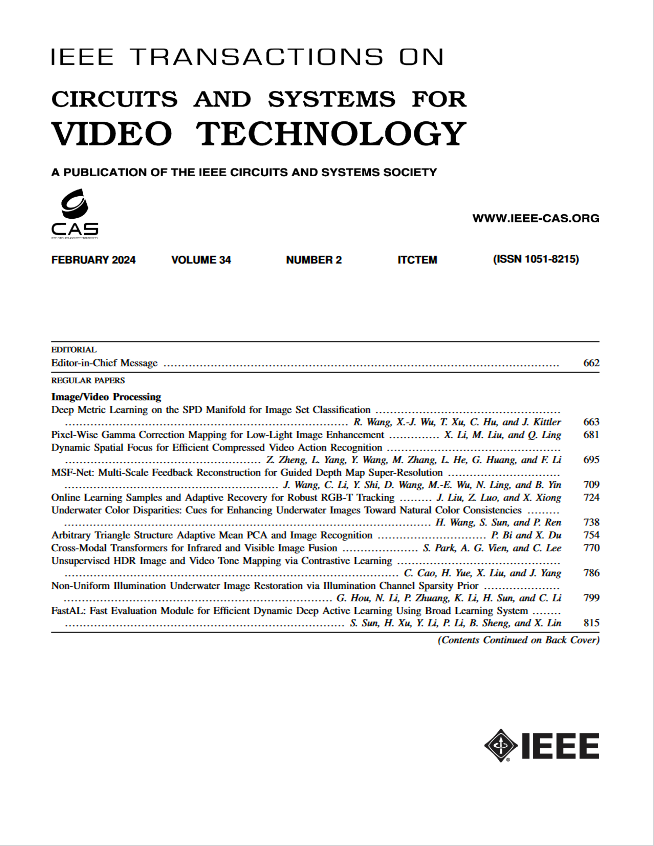光学和SAR图像多模态聚类的条件双重扩散
IF 11.1
1区 工程技术
Q1 ENGINEERING, ELECTRICAL & ELECTRONIC
IEEE Transactions on Circuits and Systems for Video Technology
Pub Date : 2025-01-23
DOI:10.1109/TCSVT.2025.3533301
引用次数: 0
摘要
光学图像通过成像机制识别不同的波长,通常比SAR图像在环境空间中嵌入更高的低维流形。如何利用它们的互补性是多模态集群的一个挑战。在本研究中,我们设计了一个用于光学和SAR图像多模态聚类的条件对偶扩散(CDD)模型,并从理论上证明了它等价于具有唯一解的概率流常微分方程(ODE)。与传统的扩散模型不同,CDD模型配备了解耦自编码器,可以同时预测噪声和清除图像,保留嵌入在潜在空间中的数据流形。针对光学图像和SAR图像的融合流形,训练模型生成以SAR图像为条件的光学图像,并将其映射到统一的潜空间中。从模型中提取的学习特征被输入到K-means算法中产生最终的聚类。据我们所知,这项研究可能是多模态聚类的第一个扩散模型之一。在三个大规模光学sar对数据集上进行的大量对比实验表明,我们的方法在聚类性能和时间消耗方面总体上优于最先进的(SOTA)方法。源代码可从https://github.com/suldier/CDD获得。本文章由计算机程序翻译,如有差异,请以英文原文为准。
Conditional Dual Diffusion for Multimodal Clustering of Optical and SAR Images
Acknowledging different wavelengths by imaging mechanisms, optical images usually embed higher low-dimensional manifolds into ambient spaces than SAR images do. How to utilize their complementarity remains challenging for multimodal clustering. In this study, we devise a conditional dual diffusion (CDD) model for multimodal clustering of optical and SAR images, and theoretically prove that it is equivalent to a probability flow ordinary differential equation (ODE) having a unique solution. Different from vanilla diffusion models, the CDD model is equipped with a decoupling autoencoder to predict noises and clear images simultaneously, preserving data manifolds embedded in latent space. To the fuse manifolds of optical and SAR images, we train the model to generate optical images conditioned by SAR images, mapping them into a unified latent space. The learned features extracted from the model are fed to K-means algorithm to produce resulting clusters. To the best of our knowledge, this study could be one of the first diffusion models for multimodal clustering. Extensive comparison experiments on three large-scale optical-SAR pair datasets show the superiority of our method over state-of-the-art (SOTA) methods overall in terms of clustering performance and time consumption. The source code is available at https://github.com/suldier/CDD .
求助全文
通过发布文献求助,成功后即可免费获取论文全文。
去求助
来源期刊
CiteScore
13.80
自引率
27.40%
发文量
660
审稿时长
5 months
期刊介绍:
The IEEE Transactions on Circuits and Systems for Video Technology (TCSVT) is dedicated to covering all aspects of video technologies from a circuits and systems perspective. We encourage submissions of general, theoretical, and application-oriented papers related to image and video acquisition, representation, presentation, and display. Additionally, we welcome contributions in areas such as processing, filtering, and transforms; analysis and synthesis; learning and understanding; compression, transmission, communication, and networking; as well as storage, retrieval, indexing, and search. Furthermore, papers focusing on hardware and software design and implementation are highly valued. Join us in advancing the field of video technology through innovative research and insights.

 求助内容:
求助内容: 应助结果提醒方式:
应助结果提醒方式:


